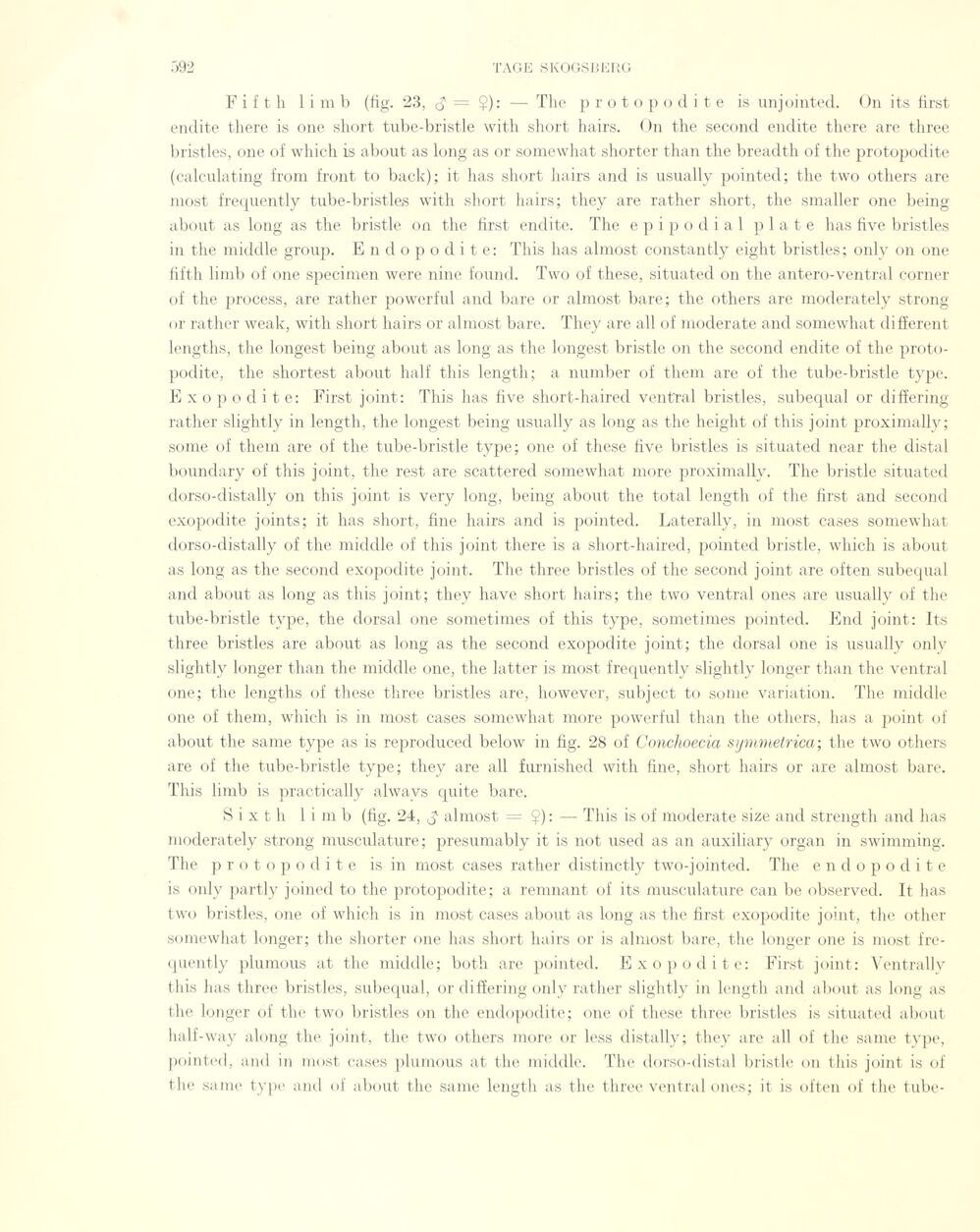
Full resolution (JPEG) - On this page / på denna sida - Sidor ...

<< prev. page << föreg. sida << >> nästa sida >> next page >>
Below is the raw OCR text
from the above scanned image.
Do you see an error? Proofread the page now!
Här nedan syns maskintolkade texten från faksimilbilden ovan.
Ser du något fel? Korrekturläs sidan nu!
This page has never been proofread. / Denna sida har aldrig korrekturlästs.
F i f t h 1 i ni b (fig. 23, <$ = Ç): — The p r o t o p o d i t e is unjointed. On its first
endite there is one short tube-bristle with short hairs. On the second endite there are three
bristles, one of which is about as long as or somewhat shorter than the breadth of the protopodite,
(calculating from front to back); it has short hairs and is usually pointed; the two others are
most frequently tube-bristles with short hairs; they are rather short, the smaller one being
about as long as the bristle on the first endite. The epipodial plate has five bristles
in the middle group. Endopodite: This has almost constantly eight bristles; only on one
fifth limb of one specimen were nine found. Two of these, situated on the antero-ventral corner
of the process, are rather powerful and bare or almost bare; the others are moderately strong
or rather weak, with short hairs or almost bare. They are all of moderate and somewhat different
lengths, the longest being about as long as the longest bristle on the second endite of the
protopodite, the shortest about half this length; a number of them are of the tube-bristle type.
Exopodite: First joint: This has five short-haired ventral bristles, subequal or di ffer i ng
rather slightly in length, the longest being usually as long as the height of this joint proximally;
some of them are of the tube-bristle type; one of these five bristles is situated near the distal
boundary of this joint, the rest are scattered somewhat more proximally. The bristle situated
dorso-distally on this joint is very long, being about the total length of the first and second
exopodite joints; it has short, fine hairs and is pointed. Laterally, in most cases somewhat
dorso-distally of the middle of this joint there is a short-haired, pointed bristle, which is about
as long as the second exopodite joint. The three bristles of the second joint are often subequal
and about as long as this joint; they have short hairs; the two ventral ones are usually of the
tube-bristle type, the dorsal one sometimes of this type, sometimes pointed. End joint: Its
three bristles are about as long as the second exopodite joint; the dorsal one is usually only
slightly longer than the middle one, the latter is most frequently slightly longer than the ventral
one; the lengths of these three bristles are, however, subject to sonie variation. The middle
one of them, which is in most cases somewhat more powerful than the others, lias a point of
about the same type as is reproduced below in fig. 28 of Conchoecia symmetrica; the two others
are of the tube-bristle type; they are ail furnished with fine, short hairs or are almost bare.
This limb is practically always quite bare.
S i X t h limb (fig. 24, J almost = Ç): — This is of moderate size and strength and has
moderately strong musculature; presumably it is not used as an auxiliary organ in swimming.
The protopodite is in most cases rather distinctly two-jointed. The endopodite
is only partly joined to the protopodite; a remuant of its musculature can be observed. It has
two bristles, one of which is in most cases about as long as the first exopodite joint, the otlier
somewhat longer; the shorter one has short hairs or is almost bare, the longer one is most
frequently plumous at the middle; both are pointed. Exopodite: First joint: Ventrallv
this has three bristles, subequal, or di fieri ng only rather slightly in length and about as long as
the longer of the two bristles on the endopodite; one of these three bristles is situated about
half-way along the joint, the two others more or less distally; they are all of the same type,
pointed, and in most cases plumous at the middle. The dorso-distal bristle on this joint is of
the same type and of about the same length as the three ventral ones; it is often of the tube-
<< prev. page << föreg. sida << >> nästa sida >> next page >>